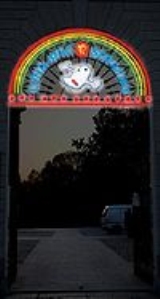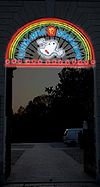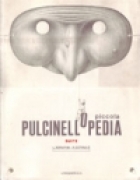
Luigi Serafini
Encyclopedia
Luigi Serafini is an Italian
artist
, architect and designer. He is best known for creating the Codex Seraphinianus
, an illustrated encyclopedia of imaginary things in a constructed language. This work was published in 1981 by Franco Maria Ricci
, out of Milan
, and of interest and inspiration to others.
aptitude, like the chairs Santa and Suspiral or the lamps and the glass for Artemide
. He has created scenery, lighting and costumes for the ballet "The Jazz Calendar" by Frederick Ashton
at Teatro Alla Scala and worked also for the Piccolo Teatro di Milano. He has done set designs for RAI
, television acronyms/logos in computer graphics. He worked with Federico Fellini
on La voce della luna
, for which he developed early designs.
 He has a laboratory of ceramics in Umbria
He has a laboratory of ceramics in Umbria
, and continues to give touring personal exhibitions, especially in Holland, and participate in art collectives. In 2003 he completed a polychrome bronze sculpture, "Carpe Diem" and other bas-reliefs for one of the Naples subway stations (Mater Dei
).
In May 2007, he held an "ontological exhibition" Luna Pac in Milan at PAC
in Milan. He occasionally gives interviews in Italian media and art publications.
Serafini has been a Banff Centre
visiting artist, and has exhibited at the Fondazione Mudima di Milano, the XIII Quadriennale, the Galleria Nazionale d'Arte Moderna
(National Gallery of Modern Art) in Rome, the Futurarium, and the Didael gallery.
In July 2008, he completed a polychrome installation "Balançoires sans Frontières" (Altalene senza Frontiere) in Castasegna, Switzerland.
was originally released as in a limited edition of 5000 artfully-bound copies in 1981. It has been republished on four occasions, first in a 1983 English language edition; then in English, Spanish, and French editions in the 1990s, each again limited to 5000 copies; and finally in a more widely printed 2006 edition.
 Many other people have been inspired by the work. Roland Barthes
Many other people have been inspired by the work. Roland Barthes
was interested in the Codex. In 1984 Italo Calvino
wrote an essay on it, which can be found in Collezione di sabbia (Sand Collection) by Mondadori. The French choreographer Philippe Decouflé
was inspired by it. Douglas Hofstadter
wrote at some length about it.
Serafini does not comment on whether the language in the text is intelligible, though it uses a carefully defined set of characters and numerals throughout.
. It is more difficult to find than the Codex, and as of 2008 has been out of print for some time.
A catalog from the Italian retrospective of Serafini's artwork, entitled Luna-Pac: Serafini, remains the only published collection of Serafini's oil paintings, drawings, sculptures, installations, and landscape art.
Serafini has also worked as a book illustrator, including an edition of Franz Kafka
's story "In the Penal Colony" and a 1988 book entitled Etimologiario by Maria Sebregondi in the style similar to the Pulcinellopedia. In 2009 Serafini illustrated Le Storie Naturali, a reinterpretation of Les Histoires Naturelles (Nature Stories) by Jules Renard
, published by Rizzoli
in a signed, limited edition of 600. This book features numerous pockets containing leaves of fantastic plants printed on heavy paper stock and die-cut to leaf shape.
Other unpublished works and illustrations are reported to exist, but aside from the occasional exhibit of art (from clay figurines to plastic and polychrome sculpture to furniture and small installations), they are not available or publicly catalogued. Serafini began his own website at luigiserafini.com, but since 2009 it has shown only a blank page.
Italy
Italy , officially the Italian Republic languages]] under the European Charter for Regional or Minority Languages. In each of these, Italy's official name is as follows:;;;;;;;;), is a unitary parliamentary republic in South-Central Europe. To the north it borders France, Switzerland, Austria and...
artist
Artist
An artist is a person engaged in one or more of any of a broad spectrum of activities related to creating art, practicing the arts and/or demonstrating an art. The common usage in both everyday speech and academic discourse is a practitioner in the visual arts only...
, architect and designer. He is best known for creating the Codex Seraphinianus
Codex Seraphinianus
Codex Seraphinianus is a book written and illustrated by the Italian artist, architect and industrial designer Luigi Serafini during thirty months, from 1976 to 1978...
, an illustrated encyclopedia of imaginary things in a constructed language. This work was published in 1981 by Franco Maria Ricci
Franco Maria Ricci
Franco Maria Ricci is an Italian publisher. Among his publications is FMR, an art magazine published six times yearly in Italian, English, German, French and Spanish, based in Milan, Italy...
, out of Milan
Milan
Milan is the second-largest city in Italy and the capital city of the region of Lombardy and of the province of Milan. The city proper has a population of about 1.3 million, while its urban area, roughly coinciding with its administrative province and the bordering Province of Monza and Brianza ,...
, and of interest and inspiration to others.
Life and works
During the 1980s Serafini worked as an architect and designer in Milan. His objects were often defined by a certain metalanguageMetalanguage
Broadly, any metalanguage is language or symbols used when language itself is being discussed or examined. In logic and linguistics, a metalanguage is a language used to make statements about statements in another language...
aptitude, like the chairs Santa and Suspiral or the lamps and the glass for Artemide
Artemide
ArtemideArtemis , in the religions of ancient Greece is the daughter of Zeus and Leto and twin sister of Apollo. She was one of the most revered gods of Olympus and its origin dates back to ancient times. [1] In Roman times she was associated with Diana, while the Etruscans with the name...
. He has created scenery, lighting and costumes for the ballet "The Jazz Calendar" by Frederick Ashton
Frederick Ashton
Sir Frederick William Mallandaine Ashton OM, CH, CBE was a leading international dancer and choreographer. He is most noted as the founder choreographer of The Royal Ballet in London, but also worked as a director and choreographer of opera, film and theatre revues.-Early life:Ashton was born at...
at Teatro Alla Scala and worked also for the Piccolo Teatro di Milano. He has done set designs for RAI
RAI
RAI — Radiotelevisione italiana S.p.A. known until 1954 as Radio Audizioni Italiane, is the Italian state owned public service broadcaster controlled by the Ministry of Economic Development. Rai is the biggest television company in Italy...
, television acronyms/logos in computer graphics. He worked with Federico Fellini
Federico Fellini
Federico Fellini, Cavaliere di Gran Croce OMRI , was an Italian film director and scriptwriter. Known for a distinct style that blends fantasy and baroque images, he is considered one of the most influential and widely revered filmmakers of the 20th century...
on La voce della luna
La voce della luna
The Voice of the Moon is a 1990 film by Italian director Federico Fellini, featuring actors Paolo Villaggio and Roberto Benigni. Returning to themes he first explored in La strada , Fellini crafts a parable on the whisperings of the soul that only madmen and vagabonds are capable of hearing...
, for which he developed early designs.

Umbria
Umbria is a region of modern central Italy. It is one of the smallest Italian regions and the only peninsular region that is landlocked.Its capital is Perugia.Assisi and Norcia are historical towns associated with St. Francis of Assisi, and St...
, and continues to give touring personal exhibitions, especially in Holland, and participate in art collectives. In 2003 he completed a polychrome bronze sculpture, "Carpe Diem" and other bas-reliefs for one of the Naples subway stations (Mater Dei
Mater Dei
Mater Dei is Latin for "Mother of God", referring to the Virgin Mary as Theotokos. The term has been used to name various institutions, often Catholic, including:-Educational institutions:*Mater Dei Academy, a Catholic K-8 school in Wickliffe, OH...
).
In May 2007, he held an "ontological exhibition" Luna Pac in Milan at PAC
Padiglione d'Arte Contemporanea
Padiglione d'arte contemporanea is a contemporary art museum in Milan, Italy. It is located in via Palestro, near Giardini Pubblici Indro Montanelli.- References :* - External links :*...
in Milan. He occasionally gives interviews in Italian media and art publications.
Serafini has been a Banff Centre
Banff Centre
The Banff Centre, formerly known as The Banff Centre for Continuing Education, is an arts, cultural, and educational institution and conference complex located in Banff, Alberta...
visiting artist, and has exhibited at the Fondazione Mudima di Milano, the XIII Quadriennale, the Galleria Nazionale d'Arte Moderna
Galleria Nazionale d'Arte Moderna
Galleria Nazionale d'Arte Moderna, or the National Gallery of Modern Art , is an art gallery in Rome, Italy, dedicated to modern art....
(National Gallery of Modern Art) in Rome, the Futurarium, and the Didael gallery.
In July 2008, he completed a polychrome installation "Balançoires sans Frontières" (Altalene senza Frontiere) in Castasegna, Switzerland.
Codex Seraphinianus
The Codex SeraphinianusCodex Seraphinianus
Codex Seraphinianus is a book written and illustrated by the Italian artist, architect and industrial designer Luigi Serafini during thirty months, from 1976 to 1978...
was originally released as in a limited edition of 5000 artfully-bound copies in 1981. It has been republished on four occasions, first in a 1983 English language edition; then in English, Spanish, and French editions in the 1990s, each again limited to 5000 copies; and finally in a more widely printed 2006 edition.

Roland Barthes
Roland Gérard Barthes was a French literary theorist, philosopher, critic, and semiotician. Barthes' ideas explored a diverse range of fields and he influenced the development of schools of theory including structuralism, semiotics, existentialism, social theory, Marxism, anthropology and...
was interested in the Codex. In 1984 Italo Calvino
Italo Calvino
Italo Calvino was an Italian journalist and writer of short stories and novels. His best known works include the Our Ancestors trilogy , the Cosmicomics collection of short stories , and the novels Invisible Cities and If on a winter's night a traveler .Lionised in Britain and the United States,...
wrote an essay on it, which can be found in Collezione di sabbia (Sand Collection) by Mondadori. The French choreographer Philippe Decouflé
Philippe Decouflé
Philippe Decouflé is a French choreographer, dancer, mime artist, and theatre director. As a child he travelled extensively around Lebanon and Morocco, before learned his skills as a teenager at the Annie Fratellini Ecole du Cirque and the Marceau Mime School...
was inspired by it. Douglas Hofstadter
Douglas Hofstadter
Douglas Richard Hofstadter is an American academic whose research focuses on consciousness, analogy-making, artistic creation, literary translation, and discovery in mathematics and physics...
wrote at some length about it.
Serafini does not comment on whether the language in the text is intelligible, though it uses a carefully defined set of characters and numerals throughout.
Other works
In 1984 Serafini illustrated Pulcinellopedia (piccola), under the pseudonym P. Cetrulo (published by Longanesi), with a suite of pencil drawings about the Neapolitan masque of PulcinellaPulcinella
Pulcinella, ; often called Punch or Punchinello in English, Polichinelle in French, is a classical character that originated in the commedia dell'arte of the 17th century and became a stock character in Neapolitan puppetry....
. It is more difficult to find than the Codex, and as of 2008 has been out of print for some time.
A catalog from the Italian retrospective of Serafini's artwork, entitled Luna-Pac: Serafini, remains the only published collection of Serafini's oil paintings, drawings, sculptures, installations, and landscape art.
Serafini has also worked as a book illustrator, including an edition of Franz Kafka
Franz Kafka
Franz Kafka was a culturally influential German-language author of short stories and novels. Contemporary critics and academics, including Vladimir Nabokov, regard Kafka as one of the best writers of the 20th century...
's story "In the Penal Colony" and a 1988 book entitled Etimologiario by Maria Sebregondi in the style similar to the Pulcinellopedia. In 2009 Serafini illustrated Le Storie Naturali, a reinterpretation of Les Histoires Naturelles (Nature Stories) by Jules Renard
Jules Renard
Pierre-Jules Renard or Jules Renard was a French author and member of the Académie Goncourt, most famous for the works Poil de carotte and Les Histoires Naturelles...
, published by Rizzoli
RCS MediaGroup
RCS MediaGroup S.p.A. , based in Milan and listed on the Italian Stock Exchange, is an international multimedia publishing group that operates in daily newspapers, magazines and books, radio broadcasting, new media and digital and satellite TV...
in a signed, limited edition of 600. This book features numerous pockets containing leaves of fantastic plants printed on heavy paper stock and die-cut to leaf shape.
Other unpublished works and illustrations are reported to exist, but aside from the occasional exhibit of art (from clay figurines to plastic and polychrome sculpture to furniture and small installations), they are not available or publicly catalogued. Serafini began his own website at luigiserafini.com, but since 2009 it has shown only a blank page.

